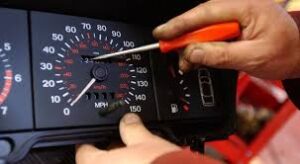Imagine paying millions for a “low-mileage” imported car, only to discover later that it has been driven twice as much. This is mileage tampering, a growing concern in Pakistan’s used car market.
Mileage tampering should be a key concern for car owners before purchasing an imported used car in countries like Pakistan. Identifying this issue of odometer tampering can help them avoid overpaying for a vehicle that is far more worn out than it appears. The buyers can also protect themselves from paying a hefty cost for any unexpected repairs later.
This blog will explain in detail what odometer rollback fraud is, highlight the common symptoms of an altered odometer, and show car owners how to avoid this scam with the help of a Japanese auction sheet.
TOC (Table of Content)
What is Odometer Rollback Fraud?
Common Signs of Altered Odometer
Mismatch of Car’s Condition
Mileage Record Discrepancies
Analog & Digital Tampering Clues
Opened or Replaced Dashboards
Suspiciously Low Mileage
Worn-Out Parts on “Low Mileage” Cars
Seller’s Suspicious Behavior
How PakWheels Auction Report Verification Helps Detect Odometer Rollback
Sum Up
What is Odometer Rollback?
Odometer rollback fraud is an illegal act of altering a vehicle’s actual mileage to make it appear as though it has driven less. The manipulation is done mechanically ( in older cars) and digitally in modern vehicles. In addition, its purpose is only to deceive buyers into believing the car is in good condition, which is the opposite of reality.
Common Signs of Altered Odometer
Mismatch of Car’s Physical Condition With Mileage
The overall condition of the car determines the original mileage. Additionally, the excessive wear on steering wheels, pedals, and seats suggests that the mileage has been altered or tampered with. The cars with low mileage do not have any worn-out signs of wear and tear.
Discrepancies in Recorded Mileage
The discrepancies between the recorded mileage and that shown in the vehicle’s service records and maintenance history are another red flag that indicates the sellers may have tampered with the odometer.
Clues of Analog and Digital Odometer Tampering
The buyers need to check the reading carefully on the analog odometer. Sometimes, the numbers are changed manually by opening the instrument cluster and rotating the dials. Therefore, they should ensure that the numbers are readable and that there are no gaps between them, which in turn assures that the odometer reading is not changed.
On the contrary, the mileage in modern cars is typically stored in the Engine Control Unit (ECU). The digital odometers cannot be easily tampered with, but the fraudsters can change the displayed mileage using software tools ( a diagnostic scan). These tools can show the difference between the displayed mileage and the mileage stored in the system.
Therefore, if the number from the scan is higher than what’s displayed on the dashboard, it’s a strong indication that the odometer is reversed.
Pro Tip: Before buying a used car, buyers should consider getting professional car inspection services for a thorough examination of the vehicle’s interior and exterior. It can help them avoid any issues and save them from paying a hefty amount later.
Opened or Replaced Dashboards
The seller suspiciously opens and replaces the dashboard for a manual odometer rollback. The signs of replacement include scratches, loose fittings, gaps between the panels, and misaligned edges.

Suspiciously Low Mileage
The buyers must be cautious if the car shows relatively low mileage and appears to be in rough condition, which may indicate a poor condition. It can be another alarming sign that helps detect mileage tampering in used cars.
Worn-Out Tires Or Brakes on Low-Mileage Vehicle
If a car has low mileage, like 15,000 to 20,000 km, its parts should still be in good condition. However, if the tires, brakes, or suspension have already been replaced or appear worn out, there may be a problem. These parts usually last much longer. This could mean the car has been driven more than what the meter shows, and the mileage may have been tampered with.
Weird Behavior of Seller
The seller’s attitude and behavior sometimes give a clear indication of any hidden issues. Therefore, car owners should be aware that if they avoid answering questions about mileage or car usage, refuse to show service records or ownership history, and end the discussion by saying, “Someone is coming to buy a car today.” It is because a verified seller will never hesitate to provide information about the vehicle’s past maintenance and service records.
After examining the symptoms of mileage tampering in imported cars, we’ll now move on to explaining how an auction sheet helps verify a car’s history and protects buyers from scams. So, keep reading the blog till the end.
How PakWheels Japanese Auction Sheet Verification Detects Odometer Rollback Scam?
PakWheels’ Japanese auction sheet verification can help buyers detect mileage tampering fraud in imported cars. They need to enter the chassis number to access the digital report, which includes the following details.
- Auction Grade
- Transmission
- Chassis Number
- Mileage
- Color
- Date of Auction
- Auction Sold Price
Once the buyer reviews the auction sheet, they can easily decide whether the car is worth buying or not. The report shows the vehicle’s actual mileage at the time of auction, which makes it harder for the seller to deceive them. All the buyer needs is the car’s chassis number to access its detailed history.
Caution: Some dishonest dealers attempt to falsify or alter translated auction sheets to conceal the car’s true history. They can change the mileage in the translated version and remove remarks about past damage and repairs.
Therefore, buyers should always request the original Japanese sheet issued by the Japanese auction house and seek verified platforms for translating auction sheets.
Sum Up
In short, mileage tampering remains a serious problem, even with digital odometers. The seller plays tricks on buyers to make a car look less used than it really is. Therefore, it is essential to inspect the vehicle carefully, watching for warning signs, including a worn-out physical condition, a mismatched service history, an open dashboard, and suspiciously low mileage vehicles with poorly maintained parts.
Last but not least, buyers can use PakWheels’ auction sheet verification service to access verified data from major auction houses such as USS, TA, JU, and ARAI. This service also helps detect mileage tampering in used cars and prevents buyers from being scammed.



Comments are closed.